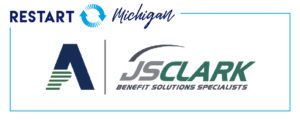JS Clark Agency: Benefits Compliance During COVID-19
August 24, 2020< Back to Full Restart Michigan Webinar Schedule

JS Clark Agency’s Compliance Director, Jennifer Young, provided context and clarification on the latest COVID-19 legislative and regulatory updates that impact employee benefits amid this complex, uncertain time.
First, Young made clear the definitions of furloughed or laid-off employees. Furlough refers to employees on temporary leave or reduced hours. They are fully expected to return to work and benefits continue through this period. Laid-off employees have been fully terminated from an organization.
Consideration for Leaves and Changes to Coverage
There are a host a group plan eligibility considerations and updates to make. Update your handbook to include leave of absence policies – including emergency and standard leave – and define your organization’s terms of furlough, layoff, and expectations for continuation of benefits. In making these updates, make sure to check with your carrier to make sure what you’re doing is in line with what they allow.
Such changes to consider include life and disability coverage. Will there be different evidence of insurability and claim eligibility? Employers must provide conversion notice for life insurance if an employee is laid off. As far as contributions during leave, employers have a few options – pre-paid, pay-as-you-go, and catch-up contributions. A lot of employers, Young stated, are even allowing reduced or waived contributions.
If employees go on unpaid leave, employers cannot require that they continue coverage during that period. If you do require coverage continuation, you must allow catch-up contributions that can be done without employee approval. For termination of coverage for failure to pay on a pay-as-you-go basis, employees must be given the same grace period as the employer has to pay the insurance company.
Considerations for Returning to Work
Employers have two options for ACA Return to Work Reinstatements of Coverage. The first is a less frequently used approach – the Monthly Measurement Period in which eligibility is determined each month based on hours worked. The second, and more frequently used approach, is a Look-Back Measurement Method in which eligibility is determined each measurement period, typically 3-12 months. Penalties to be mindful of include the A penalty, which is triggered if 95% of full-time employees aren’t offered coverage and even one employee gets subsidized coverage in the marketplace. Furloughs can increase vulnerability to this penalty. The B penalty is triggered if employees do not receive and offer for affordable coverage.
Benefits and Open Enrollment During COVID-19
In navigating this crisis, employers must allow extra time and determine distribution models to get information and coverage to employees. They should also be sure to consider COBRA participants. Coverage regarding testing in particular must include FDA-approved testing. That considered, tests must be medically necessary and ordered by a health care provider. Return-to-work testing, occupational testing, and vendor testing will not be covered. The Centers for Disease Control and Prevention are now recommending that employers not require return-to-work testing though the Michigan Department of Health and Human Services made special provisions for nursing homes.
More on These Updates
JS Clark Agency is offering two forms packages that outline these terms as well as additional legislative and administrative changes like the Families First Coronavirus Response Act and the latest IRS notices. Reach out at solutions@jsclarkagency.com or 248.355.9600 for the Coronavirus Employer Compliance Forms Package and/or Employer Reopening Forms Package.
